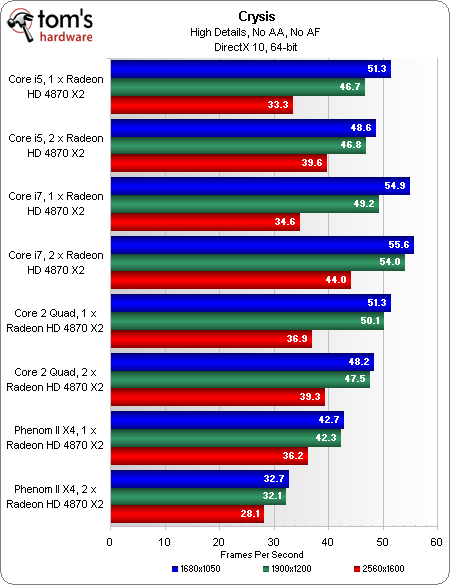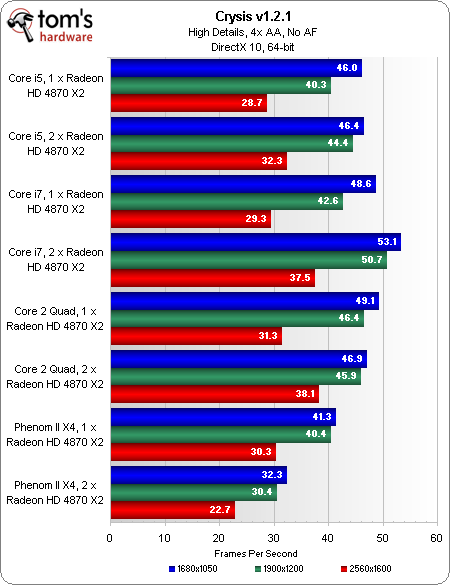In Theory: How Does Lynnfield's On-Die PCI Express Affect Gaming?
Benchmark Results: Crysis
Ah, the ageless Crysis—always surprising us with interesting results. Perhaps most problematic is that, on the 790GX platform, CrossFire results in a fairly massive performance hit that proved reproducible with Catalyst 9.6.
The results get a little more disappointing from there. Core i5 is beaten out by Core i7 by a slim margin, Core 2 Quad scores its first win against Core i5 (this is with a single card installed), and AMD’s Phenom II even slides in ahead of Core i5 as resolution increases.
Of course, the CrossFire issue results in the Phenom II getting smashed up pretty hard with two cards installed. But AMD’s configuration isn’t the only one to suffer. At 1680x1050, the Core i5 and Core 2 Quad—the two other platforms seeing PCI Express connectivity cut in half, lose a few frames each when a pair of 4870 X2s are used. By the time we switch to 2560x1600, Core i5 and Core 2 Quad actually start gaining a bit from CrossFire, but Phenom II continues shedding performance.
Let’s see if these results hold up with the added stress of anti-aliasing applied.
The backwards-slide isn’t as bad here, but there are still some notable issues. Mainly, two Radeon HD 4870 X2s in CrossFire on a 790GX platform are performing worse than one. Nevertheless, the three Intel configurations at least demonstrate gains at 2560x1600, where this potentially very I/O-limited benchmark is finally able to tax the graphics cards and show the benefit of two cards versus one. If you want a better look at Crysis performance, check out today's gaming analysis story, which tests the latest processors using their stock clocks and SSDs, opening up the frame rates substantially.
Get Tom's Hardware's best news and in-depth reviews, straight to your inbox.
Current page: Benchmark Results: Crysis
Prev Page Benchmark Results: Stalker: Clear Sky Next Page Benchmark Results: Far Cry 2-
bucifer I do not agree with the choices made in this article. You don't buy 2*4870x2 and the you slam a x4 920. The choices do not make sense.Reply
You should have used the best cpu(ex i7 920 oc@4GHz) to try to eliminate all bottlenecks and truly emphasize the limitations of x8/x16 pci-e lanes.
The rest of the testing was done to include the new i5 which is not bad but not relevant for the bottleneck. I know many people would like to see how i5+p55 handles the gpu power but it's a highly unlikely scenario that someone would actually but such powerful and expensive cards on pair them with a cheaper cpu and a limited platform.
I just think you should have tested things separately in different articles. -
radnor I know you used a 2.8Ghz Deneb for Clock-per-clock comparisons. MAkes sense. But a 2.8 Ghz Deneb is something really no unlocked. Ussually unlock versions go 3.5Ghz on stock VID, non BE PArts can reach 3.3Ghz safely.Reply
A 2.8 Deneb/Lynnfield/Bloomfield have completely diferent prices. You are comparing a R6 vs a R1. I7 is the Busa trouting everybody else. Of course the prices are very diferent. -
cangelini Gents, if you want to see the non-academic comparisons, I have the 965 BE compared in two other pieces for more real-world comparisons!Reply
http://www.tomshardware.com/reviews/intel-core-i5,2410.html
and
http://www.tomshardware.com/reviews/core-i5-gaming,2403.html
Thanks for the feedback notes! -
bounty "Will Core i5 handicap you right out of the gate with multi-card configurations? The aforementioned gains evaporated in real-world games, where Core i7’s trended slightly higher, perhaps as a result of Hyper-Threading or its additional memory channel"Reply
Well you answered will i5 handicap you without hyperthreading, x8 by x8 and dual channel. It will by 5-10% If you wanted to narrow it down to memory channels, hyperthreading or the x8 by x8 you could have pice the game with the biggest spread and enabled each of those options selectively. Would have been kinda interesting to see which had the biggest impact. -
Shnur Great article! But then again... I don't see why a 955 wasn't used in this scenario... since the 920 is thing that nobody uses. Already that we know that i7 is superior to AMD flagship in multi-GPU configurations you're taking a crappy AMD CPU, buying a 790GX doesn't mean you're going to cut on the chip... and you're talking about who's performing better in 8x lanes... from my point of view it's a bad comparison, and there should have been a chip that'll be actually able to take a difference between 1 card and two and the from 16x and 8x.Reply
And thanks for the other linked reviews, but I'm not talking about comparing the chips themselves, I'm trying to figure out is 8x still good enough or I need to pay more for 16x? -
cangelini Shunr,Reply
Thanks much for the feedback--again, this wasn't meant to be about the CPUs, but the PCI Express links. If you want to know about the processors themselves at retail clocks, check out the gaming story, which does reflect x16/x16 and x8/x8 in the LGA 1366 and LGA 1156 configs.
Hope that helps!
Chris -
Shadow703793 megabusterAMD better have something up its sleeves or it's instakill.lol! do you mean instagib?Reply
Joking aside, AMD needs something to counter this.


